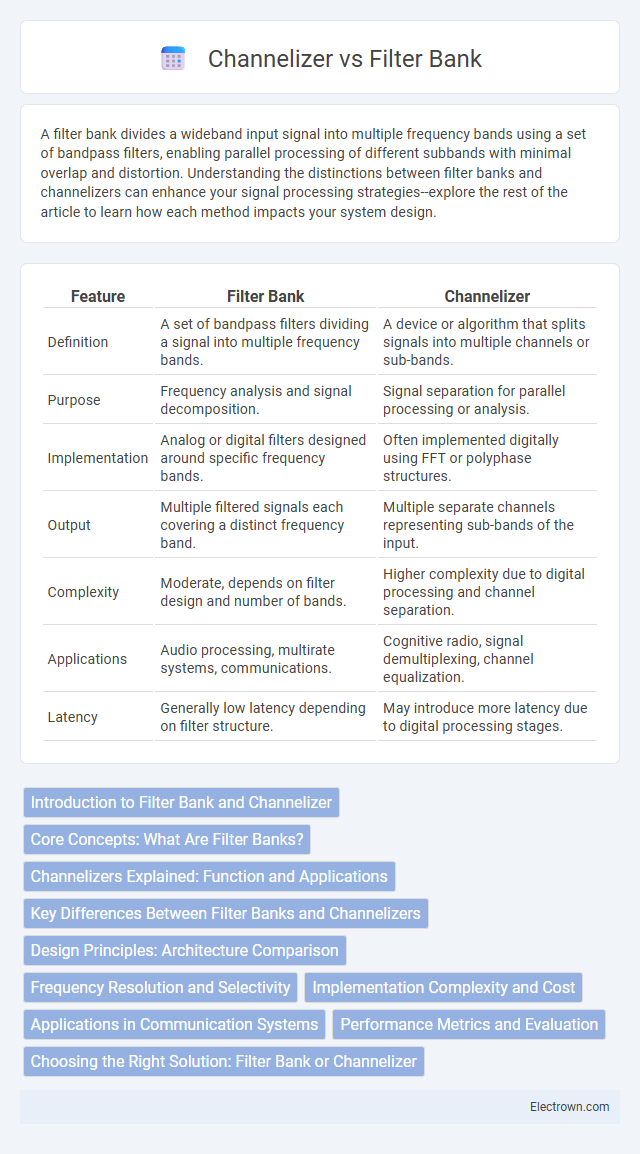A filter bank divides a wideband input signal into multiple frequency bands using a set of bandpass filters, enabling parallel processing of different subbands with minimal overlap and distortion. Understanding the distinctions between filter banks and channelizers can enhance your signal processing strategies--explore the rest of the article to learn how each method impacts your system design.
Table of Comparison
| Feature | Filter Bank | Channelizer |
|---|---|---|
| Definition | A set of bandpass filters dividing a signal into multiple frequency bands. | A device or algorithm that splits signals into multiple channels or sub-bands. |
| Purpose | Frequency analysis and signal decomposition. | Signal separation for parallel processing or analysis. |
| Implementation | Analog or digital filters designed around specific frequency bands. | Often implemented digitally using FFT or polyphase structures. |
| Output | Multiple filtered signals each covering a distinct frequency band. | Multiple separate channels representing sub-bands of the input. |
| Complexity | Moderate, depends on filter design and number of bands. | Higher complexity due to digital processing and channel separation. |
| Applications | Audio processing, multirate systems, communications. | Cognitive radio, signal demultiplexing, channel equalization. |
| Latency | Generally low latency depending on filter structure. | May introduce more latency due to digital processing stages. |
Introduction to Filter Bank and Channelizer
Filter banks are digital signal processing tools that decompose a wideband signal into multiple frequency subbands using a series of bandpass filters, enabling parallel analysis or processing. Channelizers, often implemented using filter banks, specifically separate and isolate individual communication channels from a composite signal for separate demodulation or decoding. Both techniques are fundamental in modern communication systems for efficient spectrum management and signal extraction.
Core Concepts: What Are Filter Banks?
Filter banks consist of multiple bandpass filters that divide an input signal into several frequency subbands for parallel processing. Each filter isolates a specific frequency range, enabling efficient signal decomposition and reconstruction without overlap or loss. Common applications include audio processing, telecommunications, and multirate signal analysis.
Channelizers Explained: Function and Applications
Channelizers efficiently separate a wideband input signal into multiple narrowband outputs using digital signal processing techniques, often employing filter banks or FFT-based methods. They are widely applied in communications systems for spectrum sensing, cognitive radios, and multi-channel receivers to enable simultaneous processing of multiple frequency bands. The core function of channelizers is to provide parallelized, real-time channelization with minimal latency and high spectral efficiency.
Key Differences Between Filter Banks and Channelizers
Filter banks consist of multiple filtering stages that divide an input signal into several frequency subbands, optimizing signal analysis or compression by allowing overlapping frequency bands. Channelizers achieve similar goals by using a bank of bandpass filters or FFT-based techniques to isolate distinct frequency channels with minimal interference, typically offering better computational efficiency. The primary difference lies in their implementation approach and target applications, with filter banks emphasizing flexible frequency resolution and channelizers focusing on discrete channel separation for communication systems.
Design Principles: Architecture Comparison
Filter banks use a series of bandpass filters arranged in parallel, each designed to isolate a specific frequency subband, facilitating efficient frequency decomposition with minimal overlap. Channelizers employ a polyphase structure or FFT-based approach to separate an input signal into multiple channels, prioritizing computational efficiency and scalability in multichannel processing. The architectural difference lies in filter banks using individual filters for each band, while channelizers rely on a unified transform structure to simultaneously extract multiple frequency components.
Frequency Resolution and Selectivity
Filter banks provide superior frequency resolution by dividing the input spectrum into many narrow, contiguous subbands, allowing precise separation of closely spaced signals. Channelizers implement parallel filter structures to isolate individual channels, optimizing selectivity for specific frequency bands but sometimes sacrificing fine resolution due to wider filter bandwidths. Your choice depends on whether precise signal discrimination (frequency resolution) or strong channel separation (selectivity) is more critical for your application.
Implementation Complexity and Cost
Filter banks typically exhibit higher implementation complexity due to the need for multiple finely tuned filters, leading to increased design and computational effort. Channelizers, often realized with polyphase or FFT-based structures, reduce complexity by efficiently dividing the input spectrum into subbands with fewer operations. Cost-wise, channelizers generally offer a more economical solution in hardware and power consumption compared to the extensive resources required for full filter bank implementations.
Applications in Communication Systems
Filter banks and channelizers both play essential roles in communication systems by enabling multi-band signal processing and spectral splitting. Filter banks offer flexible subband filtering ideal for multicarrier modulation schemes like OFDM, enhancing spectral efficiency and interference mitigation. Channelizers are optimized for channel selection and demultiplexing in software-defined radios, supporting dynamic spectrum access and improving overall receiver performance.
Performance Metrics and Evaluation
Filter banks and channelizers are evaluated primarily based on metrics such as frequency selectivity, computational complexity, and signal-to-noise ratio (SNR) performance. Filter banks offer fine frequency resolution and lower aliasing, enhancing signal integrity, while channelizers provide efficient parallel processing with lower latency but may have coarser frequency separation. Your choice between them should consider the trade-off between performance precision and computational resource requirements for optimal signal processing outcomes.
Choosing the Right Solution: Filter Bank or Channelizer
Choosing the right solution between a filter bank and a channelizer depends on your specific signal processing needs and system constraints. Filter banks offer superior frequency selectivity and minimal leakage for applications demanding precise sub-band filtering, while channelizers excel in efficiently splitting wideband signals into multiple channels with reduced computational complexity. Assessing parameters such as channel count, processing latency, and hardware resources will guide your choice to optimize performance and resource utilization.
Filter Bank vs Channelizer Infographic

 electrown.com
electrown.com